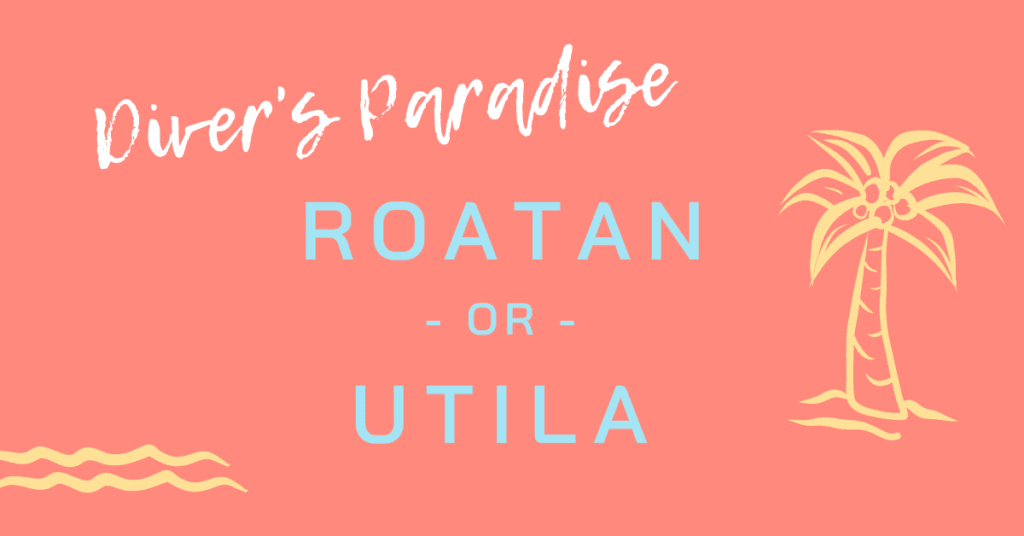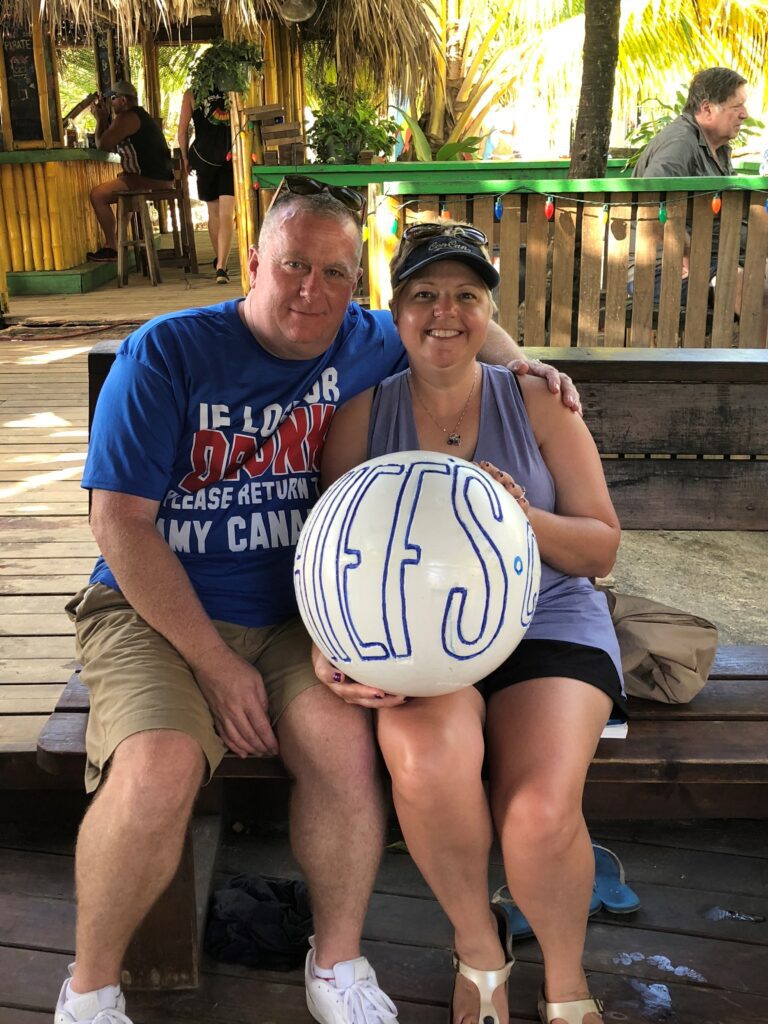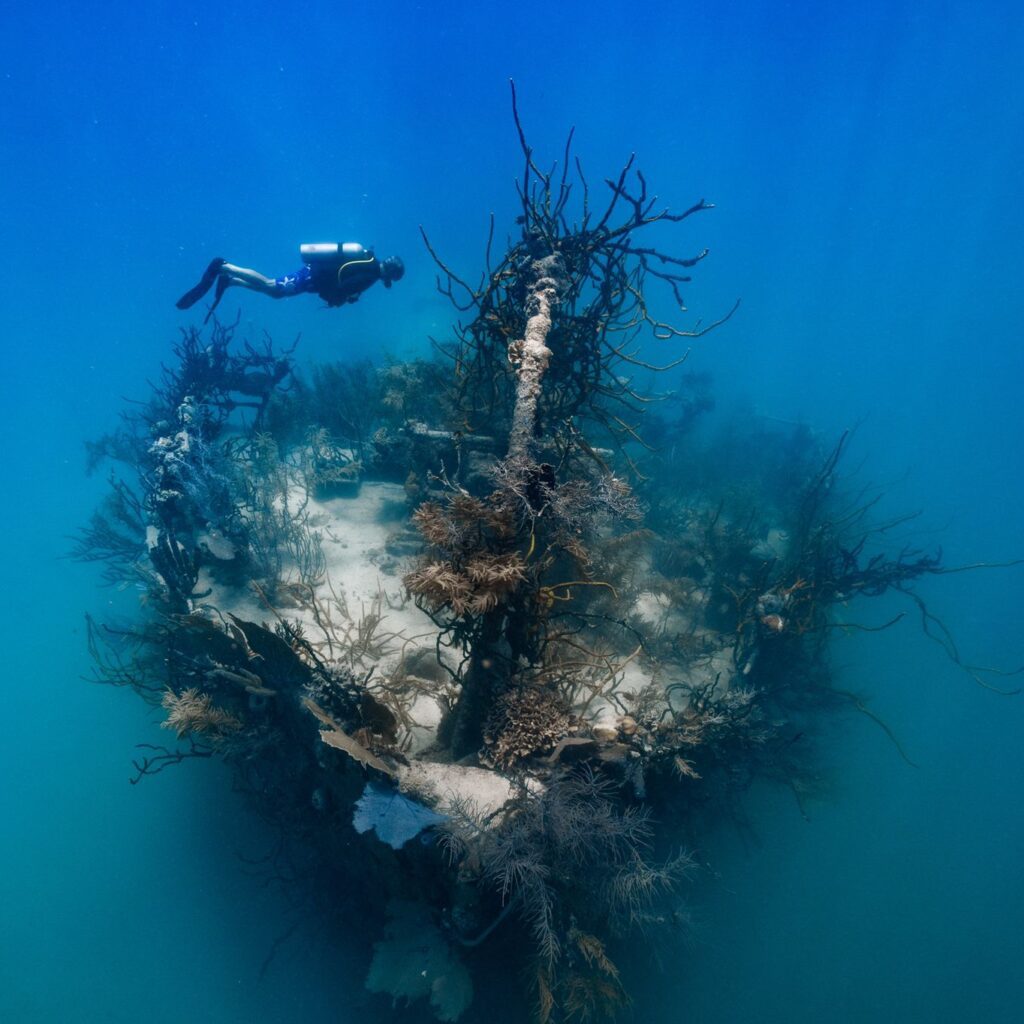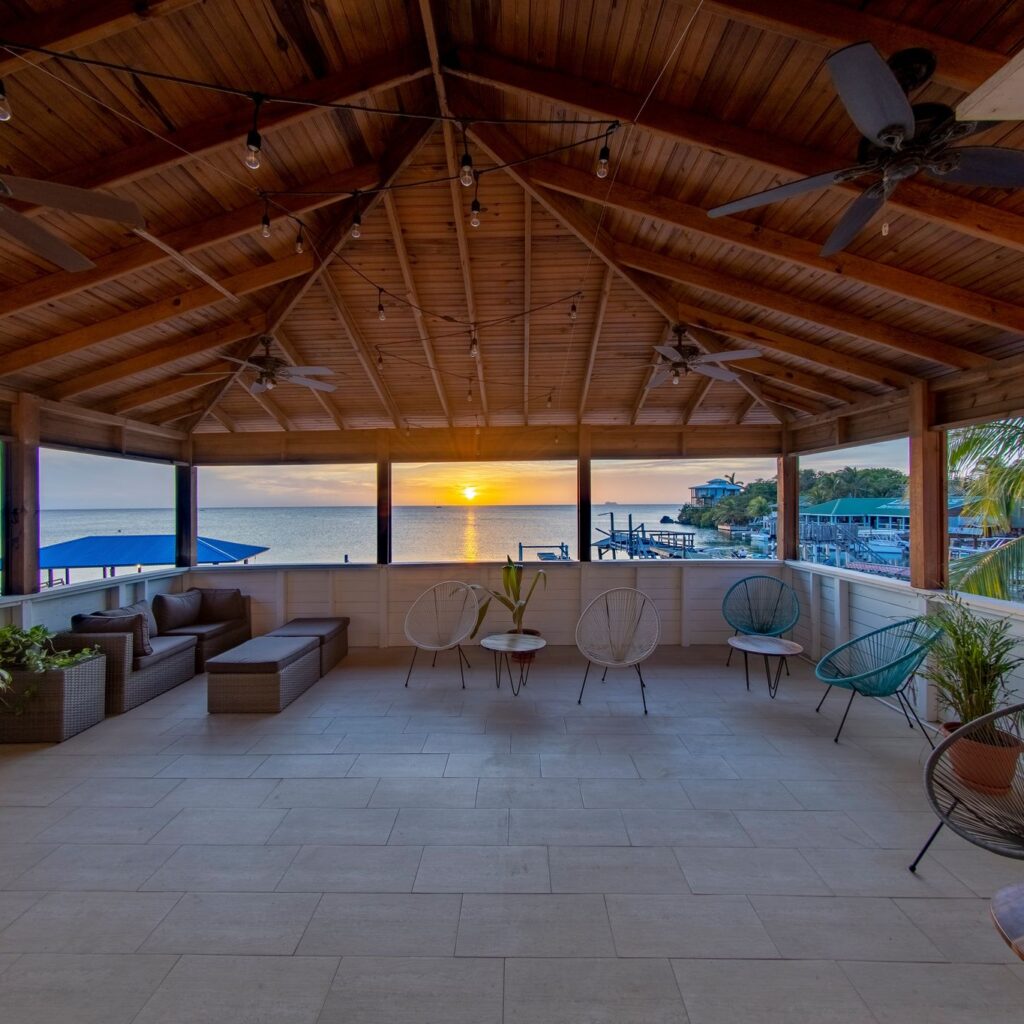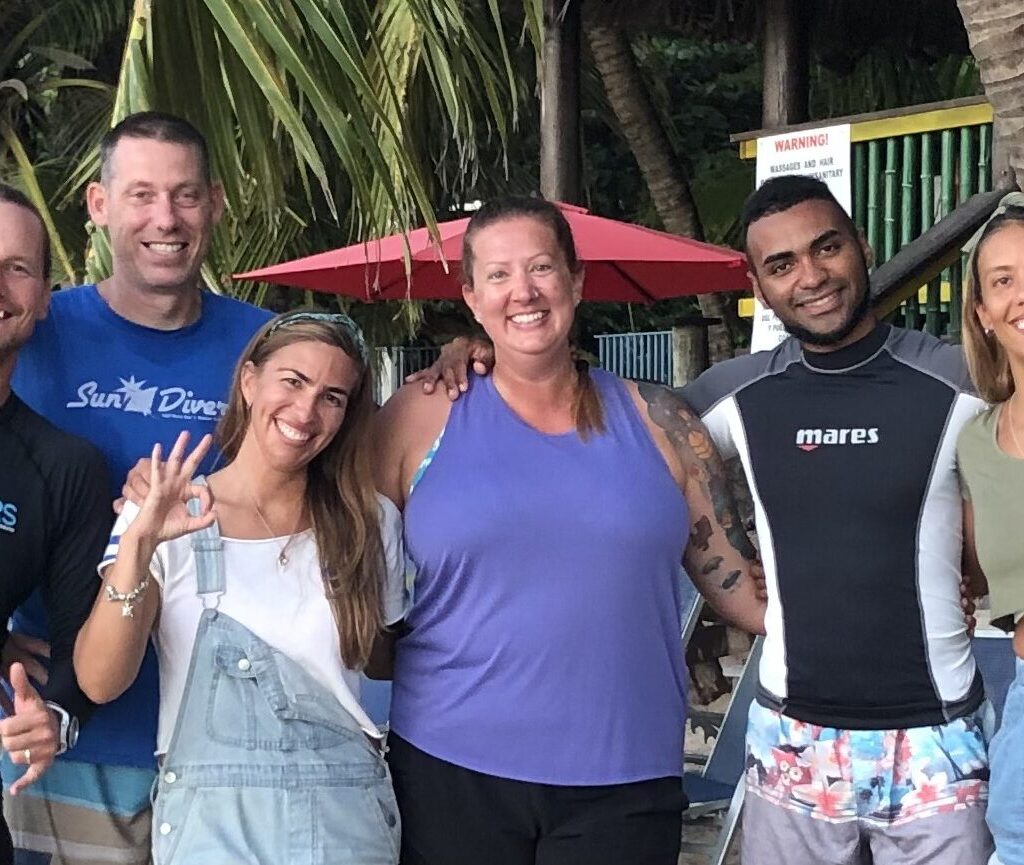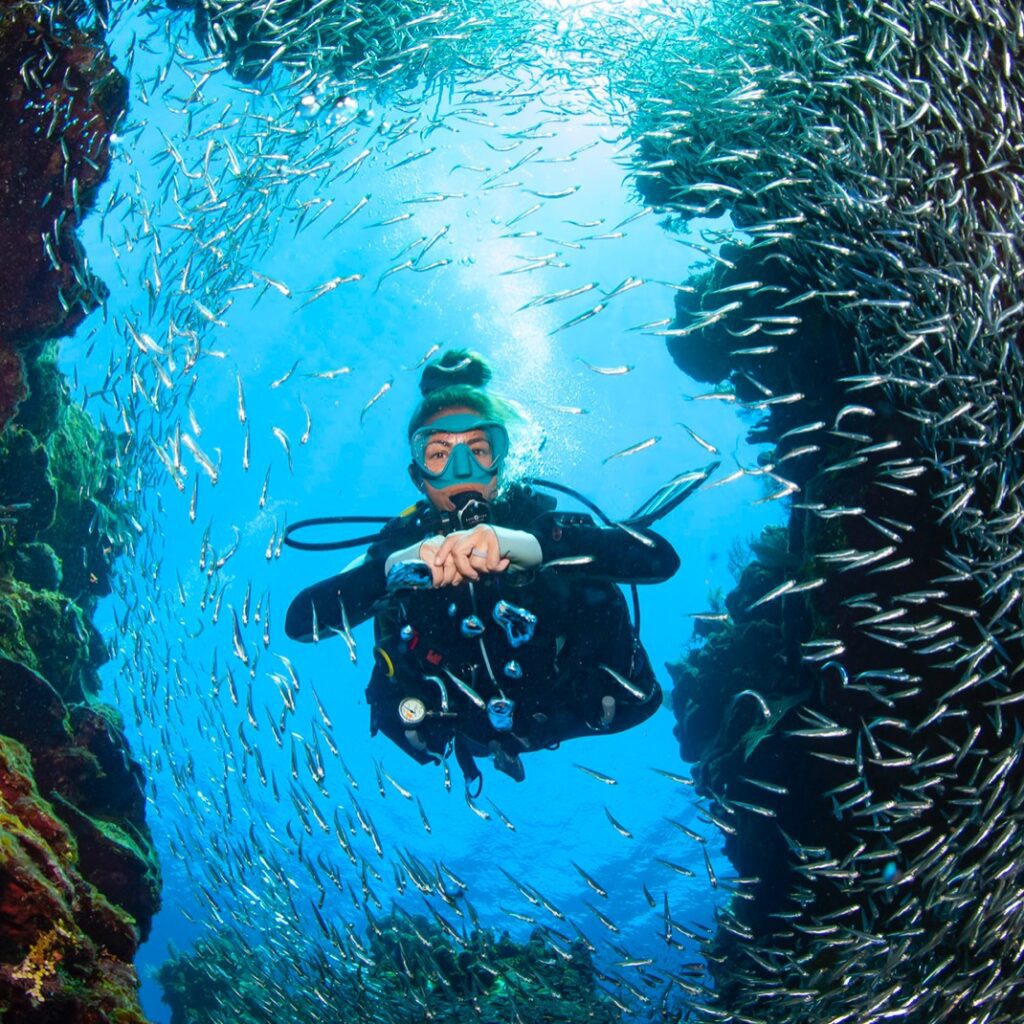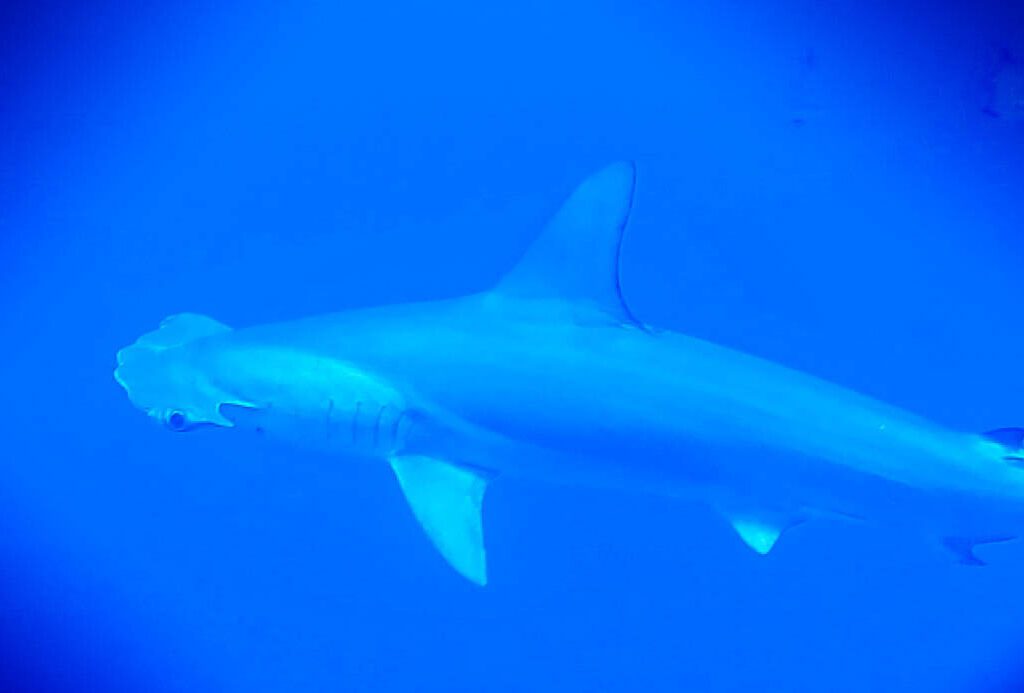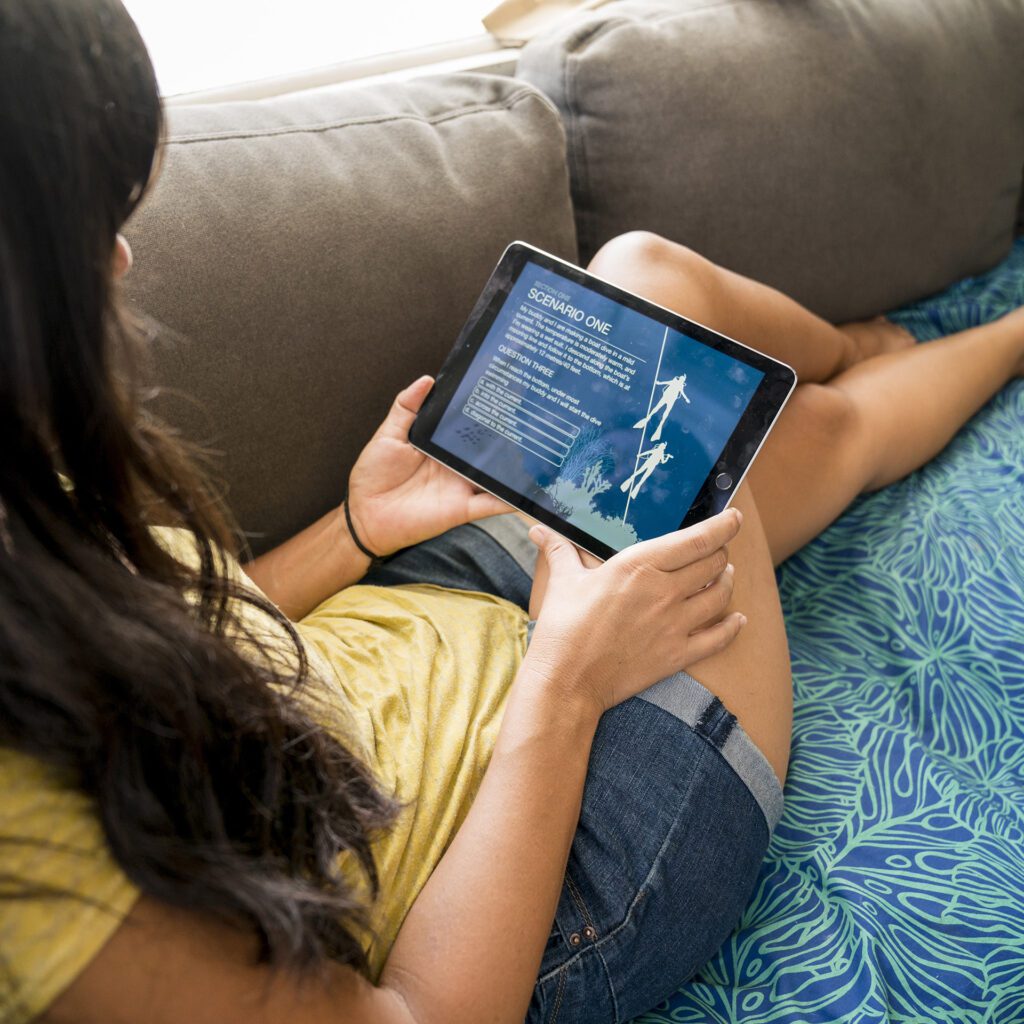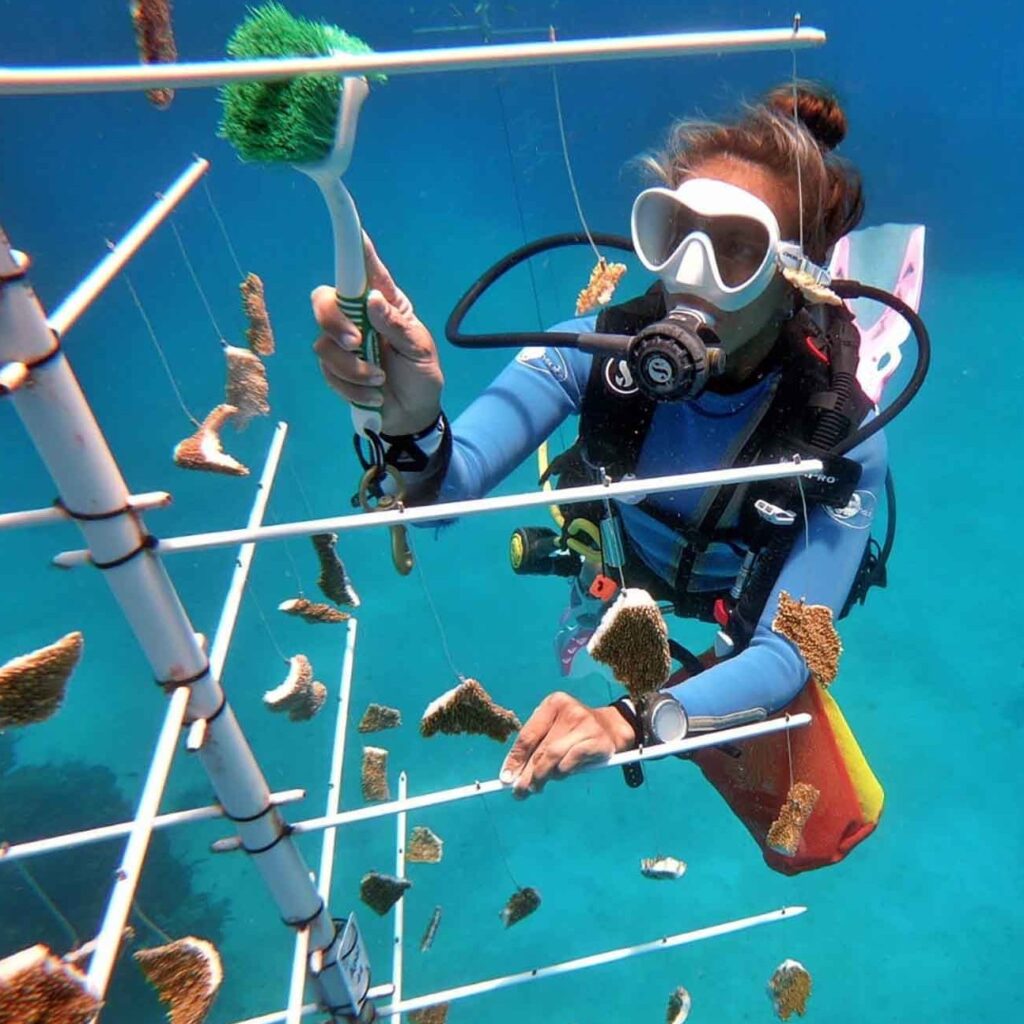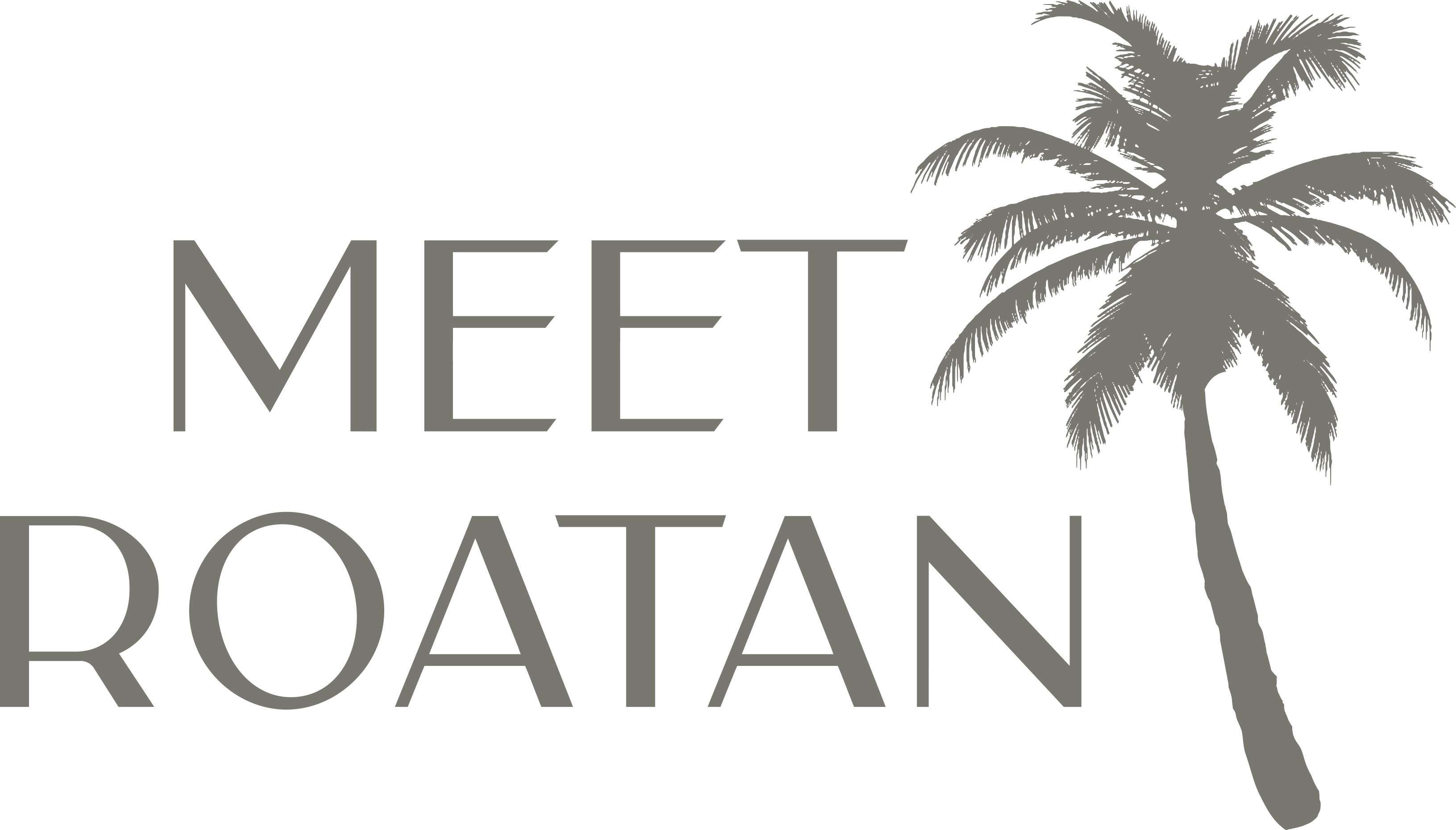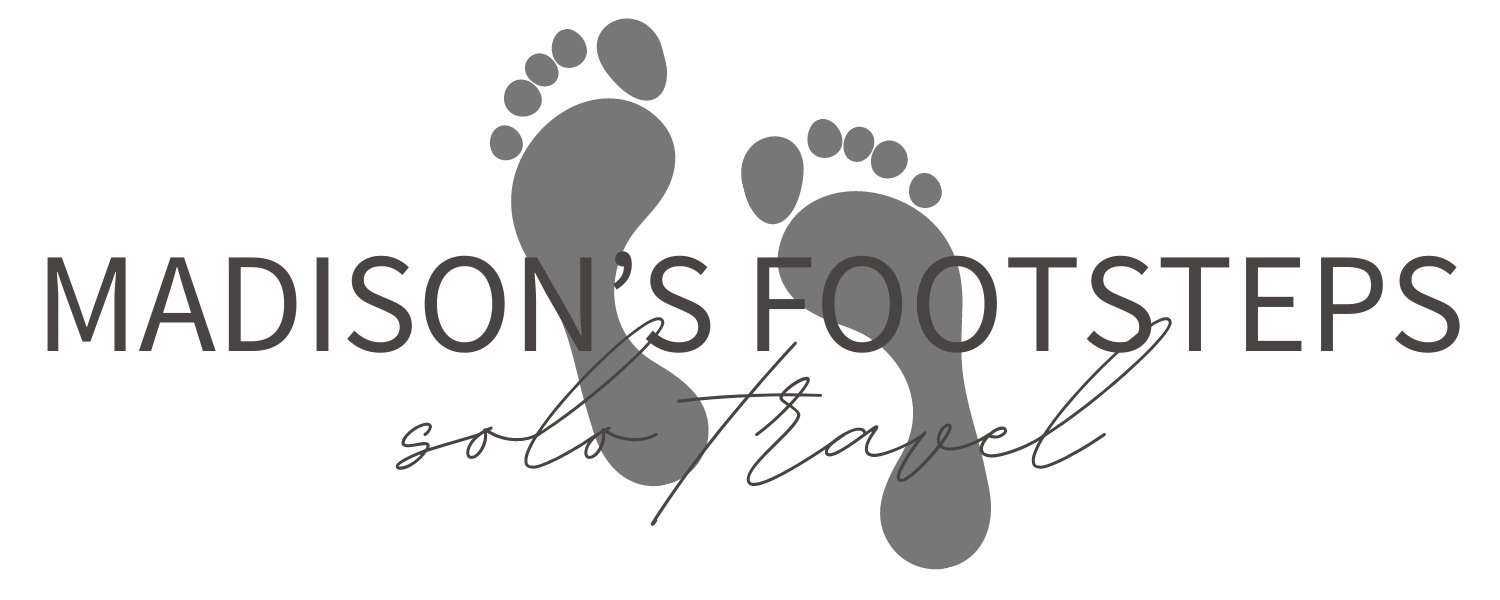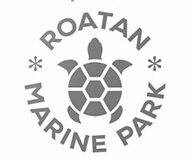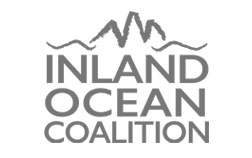By Author
Is your sunscreen truly reef safe?
As a scuba diver you’re automatically an ocean enthusiast and possibly even an advocate. And unless you’ve been hiding under a rock, you know that most sunscreens on the market contain chemicals that are damaging to that ocean environment that you love so much. But you also don’t want to end your dive trip with a funky mask tan or even worse, a mask-shaped burn – those hurt and aren’t very stylish.
To make matters worse, there are about a gazillion different sunscreen options on the shelf with half of them now claiming to be “reef-friendly”. But what does that even mean? And how do you know which one to choose?
It’s a dilemma we constantly see people facing at our dive center and have even been faced with ourselves. Which is why we’re bringing Sea2Stream suncare products to our customers and have developed this helpful resource guide for how to determine if your sunscreen is truly reef safe.
Introducing the HEL-List
According to the Haereticus Environmental Laboratory, the HEL LIST is a list of chemicals that are known pollutants in many different environments (freshwater streams, river, beaches, and ocean systems) or wildlife (e.g., corals, fish, birds, marine mammals, sea turtles). All of them pose a threat to ecosystem health.
It’s a great list to google next time you’re at the store stocking up on sunscreens or to audit what you have in your cupboards right now.
The HEL LIST includes:
- Any form of microplastic sphere or beads.
- Any nanoparticles like zinc oxide or titanium dioxide.
- Oxybenzone
- Octinoxate
- 4-methylbenzylidene camphor
- Octocrylene
- Para-aminobenzoic acid (PABA)
- Methyl Paraben
- Ethyl Paraben
- Propyl Paraben
- Butyl Paraben
- Benzyl Paraben
- Triclosan
HEL has developed a certification for reef-friendly sunscreen called the Protect Land + Sea certification, that we like because they independently test products for ingredients on its HEL-List. And the list gets updated each certification period as more research uncovers which chemicals pose a threat to wildlife. When this happens, companies must resubmit their products for certification. See which companies are willing to make this investment to protect our fragile ecosystems (spoiler, it’s a short list!).
If you want a great explainer on WHY you should avoid these ingredients, check out Stream2Sea’s Ingredients to Avoid guide.
Help Roatan Ban Non-Reef Safe Sunscreen
Sun Divers is a member of the EcoSafe Sunscreen Coalition urging the Municipality of Roatan to ban the sale and use of non-reef safe sunscreen. Learn more about this important initiative and sign our Change. Org petition if you want to protect our reef from toxic overload.
Your Health Matters Too
It’s great to make a more eco-conscious selection of sunscreens because you want to make a difference for our planet. But what’s better for the enviroment is also better for you when it comes to sunscreens. Your skin is your largest organ and it absorbs anything you put on it, both synthetic and natural. The FDA has only found two common suncreen ingredients that could be classified as safe and effective: Zinc Oxide and Titanium Oxide. But while these might be safe for use on our skin, these nanoparticles can cause development disorders in sealife.
A great rule of thumb is if you can’t pronounce it, you might not want to put it in or on your body. If you’d rather play it safe, look for UV protective clothing, wear a heat and seek the shade!
Why We Love Stream2Sea
After our own wild chase to track down reef-safe sunscreen here on Roatan, we decided to reach out to Stream2Sea to see if they’d partner with us to provide our customers with a better sunscreen option. And they said yes! This is why we’re thrilled about this partnership:
- We Share Values! Like Sun Divers, Stream2Sea is a business that believes
 that you can be good at business while also doing good, by prioritizing purpose as much as profits.
that you can be good at business while also doing good, by prioritizing purpose as much as profits. - It’s Protect Land + Sea Certified! Their SPF 30 Sport Sunscreen, which is available at our dive center, has undergone the rigorous, independent testing to determine that it is truly reef-friendly.
- No Zinc or Titanium nanoparticles! The EcoSafe Zinc™ used by Stream2Sea is naturally-coated, USP grade and Cosmos certified.
- Lotsa antioxidants! Too much exposure to the sun can release free radicals that rage on the collagen and elasten fibers in your skin. This leads to more wrinkles, dark skin spots and saggy skin, which no one wants. The good news is that antioxidants can halt free radicals from wreaking havoc on your good looks. And Stream2Sea is packed with them from ingredients like green tea, holy basil, olive leaf and aloe.
Sun Divers carries a huge selection of Stream2Sea products including their sport, mineral, tinted and glitter sunscreens, as well as using the same mask defog that we use on the boat. And the condition that almost all our staff with long hair use.. Every little step counts and we hope you’ll join our movement!
Roatan vs. Utila: Which is the best diver’s paradise?
Is Roatan or Utila better for diving? While they’re so close in proximity, they couldn’t be more different in terms of the experience they offer both under water and above on land. And if you’re already making the trek to one, it really is worth visiting the other. But if you must choose, consider a few factors to decide which island is more ‘your scene,’ including the marine life, dive center culture, island vibe and more.
Full disclosure: We’re lucky enough to live on the island paradise of Roatan – so it’s hard to make this 100% unbiased. But we’ve also been fortunate to travel the world and appreciate sound and honest advice that some travel blogs provide. So, in our attempt to pay it forward, here’s our take on the differences divers will experience when in Roatan and Utila.
Creature Features
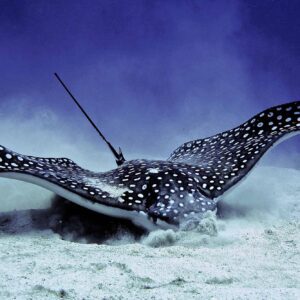
Up close encounters with eagle rays like this one are a common and always welcomed occurrence in Roatan.
Though they are part of the same MesoAmerican Barrier Reef system (the world’s second largest after Australia’s Great Barrier Reef) local conditions and reef protection efforts have a huge influence on the type of marine life that you see. We had always heard that Roatan is “fishier” and that laymen description is pretty fitting. In contrast to Utila, Roatan is teeming with life. Schools of fish, large and small, groupers, triggerfish, gobies, blennies, filefish – if you can name it, you will see it when diving Roatan. Eagle rays and sea turtles – hawksbill, green and even the occasional loggerhead – are almost guaranteed if you’re getting in at least a couple days of fun dives.
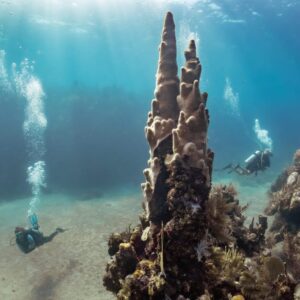
Thriving pillar coral like this one can be seen in abundance on Utila. Photo credit: Gil Sassi
What Utila lacks in its fishiness, it does make up for with its coral. We were consistently captivated by colonies of thriving pillar coral towering majestically with their polyps swaying in unison with the surge. Enormous elkhorn are the perfect focal point for photos, sun rays shining down upon them as if from the heavens (cue angelic singing). The coral life really is a sight to see.
We’ve always heard Utila is where you go to see the pelagic life in this region. Nurse sharks were certainly more prevalent than in Roatan, but the much sought-after whale shark remained elusive, and we were told that had been the case for much of the year.
Dive Site Variety
Both Roatan and Utila are fortunate to have a fringing reef, encircling the islands and allowing for diving on all sides. But with an area of 32 square miles, Roatan is almost twice the size of Utila equating to more reef to explore and a wider variety of dive sites. There are literally hundreds of Roatan dive sites around the island with a wide variety from wall dives, macro, swim throughs, wrecks and more.
Dive Center Culture
One of the more striking differences between Roatan and Utila is the dive center culture. Most dive centers in Utila are focused on being training centers for those who’ve decided to buck the traditional path to professionalism and pursue an exciting and adventurous career in the dive industry. They offer longer-term lodging accommodations with zero to a hundred packages for people who need to work from the beginner level to a professional track.
This translates into an energetic and international vibe from throes of young people who are incredibly passionate about the ocean and diving. As a fun diver, you sometimes can tag along on the training dives at a discounted rate.
This also translates into a need for bigger boats to accommodate more students in addition to fun divers. Bigger boats, usually means slightly longer travel times and many of the shops have an early-morning departure time of 7:30 a.m. compared to 8:30 a.m. or 9:00 a.m. more typical on Roatan.
So, prepare yourself for some bleary-eyed dive trips in Utila, especially if you want to take advantage of its well-known night life.
Island Night Vibes
As a mecca for youth who are seeking the sea as a way out of the normal nine-to-five corporate culture, it’s no surprise that Utila is also known as the “party island.” As one of our divers stated, “I felt like an old man.” And he was only 30 years old!
But ‘age ain’t nothin’ but a number’ and if you’ve got the energy, Utila’s got the night vibes. A stop off at the famous (or infamous) Skid Row to witness – or even participate – in the guifity challege is a must. What is the guifity challenge you ask? Well it involves copious amounts of local, herbacious alcohol and spinning until you want to yak – all for a free Skid Row shirt. Totally worth it, right?! Full Moon parties celebrating recent Divemaster and Instructor certs at the Jade Seahorse are known to be a good time. And Underwater Vision’s Trivia Nights are a who’s who of DMTs and instructors in the making.
Would you do this for a t-shirt? Not gonna lie, we might!
By contrast, Roatan’s party crowd is a more mixed demographic. It’s young and old, local and expat, and pretty much always a good time though there’s probably a lot less “swiping right” opportunities than on Utila if you catch our drift. There are monthly EDM dance parties by the beach at Tequila Jack’s in Brisas del Mar, live music and music trivia nights weekly at the iconic Sundowners Beach Bar (next to Sun Divers), late night dancing at Frank’s Hideaway and many, many more beach bar hangouts in between. We LOVE weekends at the Roatan Island Brewing Co. – I mean, where else can you find a killer brewery in the middle of a tropical rainforest? And the Roatan Local Market rotates locations and creates a cool hangout spot where you can also support local small businesses.
Accommodations & Remote Work Challenges
Lodging options is probably one of the starker differences between Utila and Roatan. While Roatan has something for everyone from hostels and dorm rooms to boutique hotels and luxury vacation rentals, options in Utila are a bit less varied. Looking for a place to stay in Roatan? Contact us for our list of “diver approved” lodging options for every budget size.
People often describe Utila as a backpacker locale, and the lodging options show why. There are many hostel options, budget AirBNBs, but luxury or boutique accommodations are very limited. We stayed at one of the newer hotels called
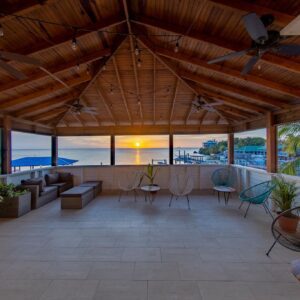
Roatan Beach Desk is one of the places where you can work in both beautiful and functional spaces.
the Manurii Boutique Hotel and found it to be a beautiful little boutique oasis that we’d happily return to – though one of us (who’s 6’4”) would appreciate a hotel with a king bed.
While we were there solely for vacation and happy to disconnect, we experienced a few long-lasting power outages that we noted would make working remote from Utila quite challenging. We were told that daily power outages could be expected and that sometimes there are days when you only have a few hours of electricity. This can be an excellent forcing function for anyone who needs to learn how to disconnect and live in the moment, but would present challenges if you’re looking to work while you get your wanderlust in.
We find Roatan to be the perfect paradise for digital nomads with many accommodations providing high speed cable internet and infrequent and usually scheduled power outages.
So how to choose?
Don’t! Visit both and contrast and compare for yourself!
But if you have to decide, think about what element of travel is most important to you and which island is going to fulfill that best. Maybe you want to dive hard and play harder and need a night life scene that can meet your night owl tendencies. Or you have a certain living standard you want to meet wherever you rest your head and want a wide variety of dive experiences on the daily.
Wherever you choose, we promise the Bay Islands will not disappoint and you’ll only leave wanting to come back for more.
Looking for more personalized advice to help plan your dive trip? Feel free to contact us for more details on diving and vacationing in Roatan and the Bay Islands.
Remembrance and Restoration: The Story of The Chief’s Quarters
The Chief’s Quarters is more than just a dive site on a map. It’s a remembrance of a great man who was a medaled Navy officer and lover of the sea. It’s also a site that is a training ground for new scuba lovers, an exploration ground for experienced divers and the birth site of many new coral colonies as the designated out planting site of the Roatan Marine Park Coral Restoration program. Here’s what makes The Chief’s Quarters special to Roatan and to the people who dedicated it to our dive community.
How The Chief’s Quarters came to be
Like so many of us, Roatan is Dave & Amy Canaan’s happy place. When they decided to make Christmas gifts more about experiences than presents, their daughter Madison chose for the family to get Open Water certified in Roatan. Now its their home away from home; where they’ve made many happy family memories and have connected with many newfound friends! And come 2022, Roatan will become their actual home – just to give you a sense of how much they love this place!
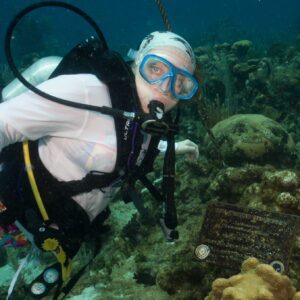
The Chief’s granddaughter Madison at the dive site dedicated to her grandfather.
And while they’ve been fortunate to share this happy place with many friends & family, the one person they never got to share it with was Dave’s dad, Richard Canaan – the very person who inspired Dave’s love for the ocean.
So, while Dave and his family couldn’t share Roatan with Richard in life, he decided they’d share it in spirit. On February 23, 2018, the Canaan family dedicated the site to his father through the Roatan Marine Park’s Name a Dive Site program.
The Name a Dive Site program offers people a way to demonstrate their commitment to Roatan’s community while honoring loved ones. It also supports the RMP Marine Infrastructure Program funding the installation of mooring lines that help increase diver access to the Mesoamerican Reef in Roatan, while decreasing mechanical damage to the reef caused by anchoring.
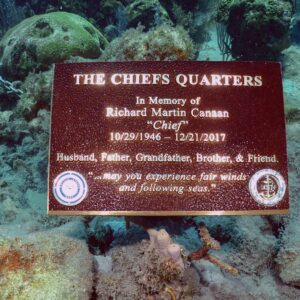
The Chief’s Quarters dedication plaque.
The dedication of the site included the installation of a plaque that sits at the base of the mooring line reading “…may you experience fair winds and following seas.” According to the Department of Navy – Navy Historical Center: ““Fair Winds and Following Seas” is really two quotes originating from different sources. The two quotes are a nautical phrase of good luck–a blessing as it were–as the person, group, or thing it is said to departs on a voyage in life.”
Over the years, Dave and Amy have shared the site with many of Richard’s loved ones including a group of 49 friends and family members who took a cruise to Roatan and were able to snorkel and dive the site. Recently, Dave’s sister Wendy did her Discover Scuba Diving experience, getting to connect with the memory of her dad and the ocean that he loved from the beautiful depths below. She’s now on her way to becoming Open Water certified.
Meet ‘The Chief’
Richard Canaan was a husband, father, grandfather, brother and friend. He was also a diehard Kansas City Chiefs fan and a Navy man, earning the patriarch of the Canaan family the nickname and title of ‘The Chief.’
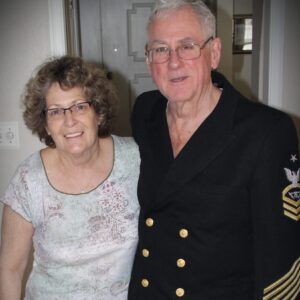
Richard Canaan, a.k.a. The Chief, with his wife Gayle Canaan.
The Chief who dedicated 22 years of his life to the U.S. Navy and then another 22 years in the Civil Service, was stationed in Japan, Norfolk, VA., San Diego and Port Hueneme Calif., and Jacksonville, FL.
One of Dave’s fondest memories is flying to Hawaii as a young boy (twice) and sailing on the Navy ships with his father back to San Diego.
Richard was always a proud Navy man who would stop and talk to any other fellow Navy man regardless if it was a grizzled old vet like himself or someone newly enlisted. He could always be seen wearing a navy hat from one of his service stations or drinking coffee from a cup emblazoned with a ship on which he had served. Right up to the day that he lost the fight with Alzheimer’s he was always Navy proud. He might not have remembered everything he did for his family, friends, and Country, but we will never forget.
Why we love The Chief’s Quarters
We like to say we’re more than a dive center, we’re a community center for diving fanatics. And Amy and Dave have been a longtime part of that community, fun diving many times a year and supporting our team from afar when the pandemic had put a halt on the fun.
Over the years they have become as much a part of our family as we’ve been of theirs. And the Sun Divers team has been honored to get to be there for so many fond memories, including those that have happened at The Chief’s Quarters. Which is why the site means a lot to us.
But “Chief’s” as we call it, is a Roatan dive site that means a lot to the whole community. That’s because Chief’s Quarters is a dive site that’s perfect for everyone: snorkelers, new divers and experienced divers. The mooring line sits on a sand patch at 20 feet which offers an expansive area for instructors and students to perform Open Water and Advanced Open Water skills, and at night it becomes the perfect place for divers to safely shut off their lights and become bewitched by the bioluminescence phenomenon The String of Pearls.
From there it gives way to long and slowly descending plateau at 40-50 feet, and then the wall that drops to 120 feet before it hits another sandy decline. It’s a common area to spot both Hawksbill and Green Turtles.
And its memorial plaque is diligently protected by Threespot Damselfish. Like a good mate, he’ll dash out and squawk at you for even laying so much as a finger on The Chief’s plaque. It’s always hard not to LOL underwater at the fishes’ hyper territorial protectiveness. Dave and Amy are convinced there is a little bit of the “Chief” in that fish who can be a bit ornery!
The Chief’s Quarters is also an important site for the future of the Mesoamerican Reef. It is the designated out planting site for The RMP Coral Restoration Program since it meets the optimal depth requirements for Elkhorn and Staghorn. Since June 2020, restoration efforts have yielded out-planting of 340+ fragments.
In September 2021, Amy decided she would become a certified Coral Ambassador. She was excited about the opportunity to leave the Roatan reef a bit more beautiful (and healthier) than she found it, but she was ecstatic when she learned that the very place these activities would happen was the site dedicated to her father-in-law.
Want to check out The Chief’s Quarters for yourself?
Contact us to plan your next diving trip in Roatan. “Chief’s” as we call it will likely be one of the many spectacular Roatan dive sites you have the chance to explore.
Want your own dive site?
Interested in memorializing someone you love – or just your love for Roatan and diving? Consider supporting the Roatan Marine Park’s Name a Dive Site program. You can find more details here.
‘Southside Days’ bring year-round diving in Roatan
Whether you are traveling to Roatan for the first time or are a regular visitor, you can always assume the tropical weather will throw some curveballs during your vacation. That’s just the small price we pay to enjoy the pristine beauty of a remote island in the Caribbean.
People often ask, “will rain effect our dive trip?” Or they see high winds and high seas in the forecast and automatically assume the weather is going to prevent them from diving.
Will Weather Affect My Diving in Roatan?
The short answer is “No.” And this answer is right about 99% of the time. The long answer is this:
There are always exceptions, but with “rainy season” actually comes unique diving opportunities when you’re diving in Roatan. Before looking into those specifics, let us take a step back and explore how the weather impacts the island.
Wind Matters Most
Roatan is shaped a bit like a sideways banana, running 48 miles long / 77km from southwest to northeast. What direction winds are traveling in, their strength and how they hit the contour of the island are the biggest variable in perfect dive conditions on Roatan.
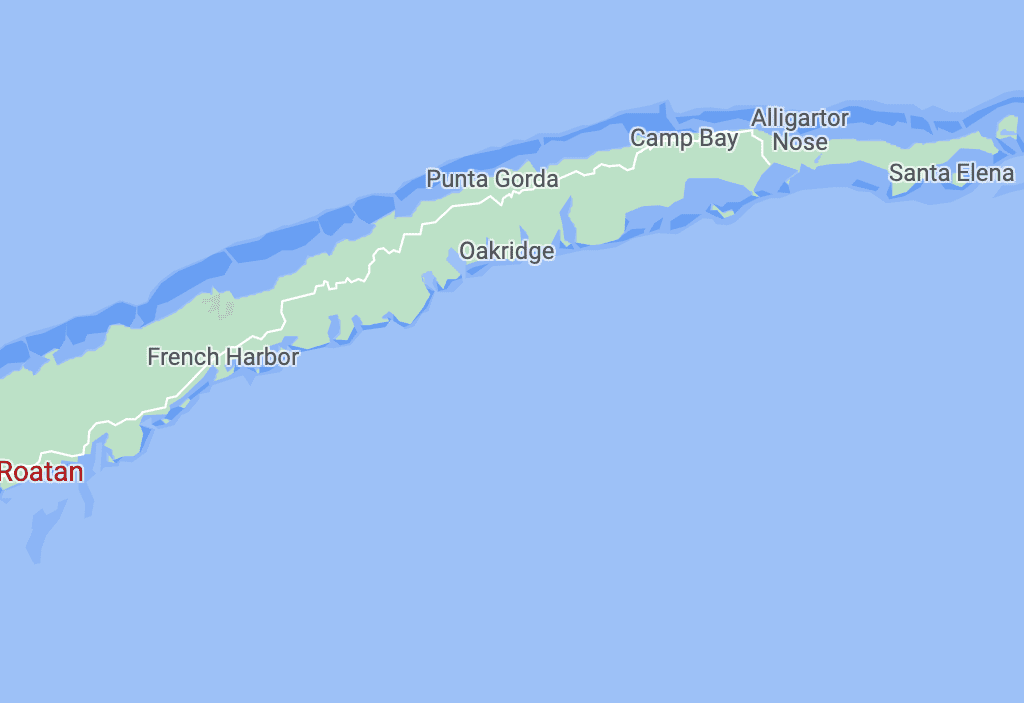
For the majority of the year, trade winds cross the island from east to west. This makes the Eastern and Southern side of the island very rough. Conversely, the mountainous island impedes the wind resulting in flat calm seas on the Western edge and Northside of the island.
Fortunately, Sun Divers is perfectly situated on the western coast of the island on one of the Caribbean’s most idyllic spots on the beach in Half Moon Bay. The low wind and calm seas create the perfect conditions for diving in crystal clear water.
However, during the rare days when the wind shifts directions and makes western Roatan rough, there is a major silver lining: The Southside becomes calm.
In some rare moments, the winds will come from the southeast, and these are the days when conditions on either side of the island have to be monitored for safe diving. But these days are the rarest of them all.
How We Monitor Weather
Ensuring that we select the right side to dive on and the right sites to take you to is a matter of both safety and enjoyment. So, we take it seriously.
We use multiple weather forecast resources, including Windfinder, Windy, Weather Underground and the helpful local forecast from Roatan Weather.
It’s not secret that weather forecasts are well….semi-reliable at best (insert bad joke about weathermen), so we also assess conditions in real time with team members making early morning drives over to the Southside to verify wind and wave conditions for that morning.
Calls regarding weather’s influence on diving are made based upon insights from these resources, as well as the experience of our boat captains and dive instructors who have an almost innate sense when it comes to reading local weather conditions.
We also continuously monitor the weather, even when you’re underwater blowing happy bubbles, so that we can be prepared to adjust our plans for the next dives if needed.
You can always rest assured that we’ve got you covered when it comes to selecting optimal dive conditions.
The big debate: Southside vs. Northside
When we head south, we call this a: “Southside Day.”
Instead of leaving from the beach behind the shop, we take the boats to our dock on the Southside and transport all of our customers via luxury bus. The ride takes no more than seven minutes.
When divers hear this plan, the immediate next question is: “Is diving on the Southside as good as the North?”
The short answer here is “Yes!” The long answer is:
There isn’t one side that’s better than the other. They’re equally fantastic, yet different.
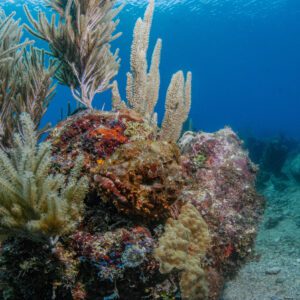
A scorpion fish sites amongst the garden-like soft coral.
The Southside is considered “more dramatic” with a shallow and short plateau giving way quickly to sheer walls. The south is also known for having more soft coral that delicately sway creating the illusion of an underwater garden. And Southside days give us the opportunity to explore uniquely captivating sites such as Keyhole, Blue Cave, the Prince Albert wreck, and the iconic Mary’s Place.
In contrast, the Northside has a gently sloping plateau ranging from 15 to 60 feet that then gives way to a wall drop off. The water on this side tends to be more nutrient dense, making this side of the island “fishier,” teeming with schools of fish as well as larger predatory fish. On some sites, you can cruise across the plateau for more than 10 minutes before you hit the wall, and there are many sites with sandy shallows that make for fun macro critter hunting in the sand and amongst coral heads.
Regardless of which side you’re on, there’s always adventure and exploration waiting for you.
And you can rest assured that a rainy day will not dampen the dive trip you have planned for months. So what are you waiting for? Book that next dive trip!
Why Roatan is Great for Digital Nomads
Working remote in Roatan is totally possible. Find your work-dive balance as a digital nomad in one of the Caribbean’s top dive destinations.
This is NOT a sponsored blog. Just us sharing our opinion!
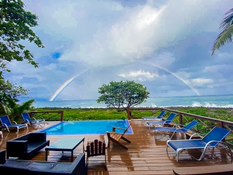
Coco Lobo was our first temporary home on the island and the WFH views were not shabby.
Hi, my name is Shannon, and I am a recovering workaholic.
As dreams go, in my opinion, I have hit the jackpot: Along with my wife, I own an amazing dive shop on a tropical beach on the island of Roatan. This dream has been in the works for decades and finally came true this year. While our story has interested and even inspired people, I would be the first to admit that the leap we took is not for everyone.
The reality is not everyone is ready, willing or able to step away from lifelong careers to pursue a less stressful existence. Luckily, these days you don’t have to. There are ways to work hard and still have enough hours in the day to do things that recharge you (like diving). It is possible to feel like you’re working to live, and not the other way around.
How you can find work-dive balance
While the COVID-19 pandemic turned everyone’s world upside down, it taught many companies and individuals that entire teams don’t need to be tethered to a physical office to keep business running.
Enter the age of the digital nomad. Digital nomads are defined as freelancers, entrepreneurs, or employees with flexible bosses who need only a laptop to work from wherever they want. And they want to work from somewhere with a good quality of life….usually in a remote or international location.
There are many benefits of a remote work culture. Increased job (and life) satisfaction, productivity and balance, and decreased overhead costs, and carbon footprints with a reduction in commutes.
The trends toward more remote working were already steadily increasing, even before COVID struck. Now that COVID has a firm grip on every aspect of our work culture, it is estimated that 70% of employees will be remote by 2025.
Now that I’ve given you plenty of ammunition to successfully ask your boss to make this big change, we can focus on the fun part:
Deciding where to work remote
You’ve decided to make remote work a new part of your lifestyle. Now you need to decide on where you would like to work from. The beauty is that you don’t have to choose just one place forever – hence the nomad part of this. You can move as often as you want, and as often as your pocketbook (or boss) will allow. But wherever you choose to satisfy your wanderlust, it needs good internet, reliable services (power, water, and cell towers), access to stores for groceries & household goods, and a reasonable cost of living.
Allow me to introduce you to Roatan!
Roatan is an island about 40 miles off the northern coast of Honduras. It is 47 miles long and no more than 5 miles wide, yet the largest of the Bay Islands, and surrounded by some of the most spectacular Caribbean blue water you have ever seen. It’s also fringed by the world’s second largest barrier reef: the Mesoamerican Barrier Reef. If you are into diving, snorkeling, kite surfing, or just relaxing on the beach… there is an endless number of things to do and see. The island is atop an ancient reef and it is mostly tropical, untouched jungle. It’s still relatively less commercialized than most island locations, making it still a hidden Caribbean gem. But the island is having its moment as seen on The Today Show, Fodder’s and Conde Nast. And there’s no better time than the present to experience it.
Why Roatan is Great for Digital Nomads
Before my work attire completely switched from business suits to bathing suits, I worked remotely here in Roatan. I experienced firsthand whether you can be reliably connected with a demanding job or not. Spoiler alert: you can! Here’s what I think makes Roatan great for digital nomads:
Reliable Wifi
Are you side-barring on slack, while trying to maintain enough eye contact with your everyone in your zoom room to look interested in Q4 planning, but also wanting to sneak a peek at your phone and see how many people liked your last Instagram reel? While the speed in Roatan’s high speed network is maybe more akin to a station wagon than a Ferrari, it is consistently reliable. Fiber internet is now available on the island and many rental homeowners are making the upgrade. My personal speed tests with MAX show that typical download speeds are around 10mb, and while that’s snail-like compared to your Google Fiber it’s enough to make sure you can share your screen and come in loud in clear when it’s your turn to hit present. Sure, you may have to limit the number of internet-based applications you’re running at a single time, but multi-tasking isn’t good for you anyways.
Reliable Utilities
As important as reliable internet is reliable electrical power, cell service and even water and gas. While the other Bay Islands deal with almost daily power outages, Roatan’s are very infrequent these days and almost always scheduled with advanced notice. Sure, you’ll get the random car crash or fallen tree that takes out a power line – but those instances are rare. Likewise, you see few interruptions in cell service or water and gas delivery (both of which happen by trucks that make daily rounds through the neighborhoods.) Now this isn’t to say that it never happens. Remember, you are living on a remote island. But it happens less often than you would expect.
Coworking and Coffee Shops Galore
While we don’t have a Starbucks on every corner, we have a surprising number of hip coffee shops and cafes with tons of character, excellent local java to help keep the creativity flowing and a nice work ambience. We still break away to the coffee shop when we need to focus on big projects for the dive shop and Bean Crazy, Café 314 and Café de Palo are just a few of our favorites. If you want to start Fri-yay a little early or have to clock some hours over the weekend, the Roatan Island Brewing Co. is one of the best spots to meet that project deadline, celebratory microbrew in hand.
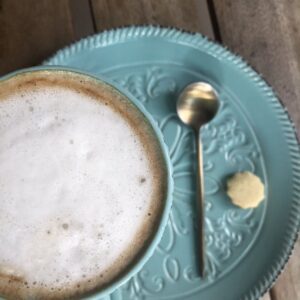
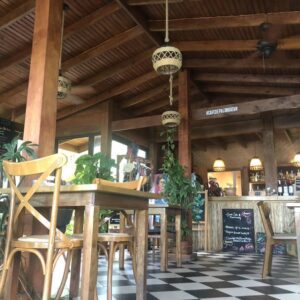
Super chic coffeehouse vibes, a cool ocean breeze and killer lattes make Café de Palo a personal favorite.
Don’t want the coffee grinder interrupting you team meeting? Or maybe you need to feel like your “going to the office” to really be productive. While life does progress a bit slower here, we’re way ahead of the curve when it comes to co-working spaces. Right in the heart of West End, is a brand new, modern coworking space called Beach Desk. It has all the common amenities of coworking spaces (fully equipped work stations with monitors, keyboards and mouses to connect to your laptop, private phone cabins, meeting rooms and conference/event space) with the added bonus of an inspiring view from their terrace right above the water. They also have a backup generator so not even the scheduled power outages can be an inconvenience and they are expanding the space to include private offices soon.
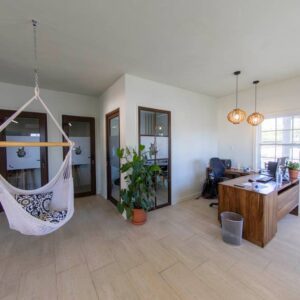 .
. 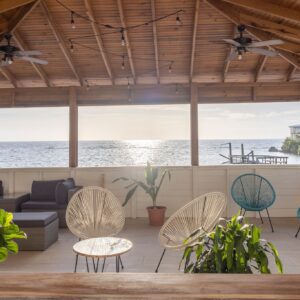
At beach desk, everyone has an office with a view.
Proximity to Nature
Think back to a time you felt happy, relaxed, recharged. You were probably somewhere in nature. And if you’re like the majority of people, you were probably by the blissing out by the ocean. While most must take the coveted three-day weekend to make a break for their happy place, when you live in paradise you can get there before your boss even has the chance to hit send on their “sorry to bother you after hours” email. In fact, you’ll be so close to your happy place that you can easily block off a “productivity pod” to recharge with a session of sun yoga, a swim in the bay or an afternoon or night dive.
In addition to these important remote work amenities, Roatan also has a number of local gym facilities, spas, fantastic restaurants of every persuasion (you can even find Pho here!) grocery stores stocked with your favorite brands (albeit for a bit more money since their imported) and local fruit markets, seafood vendors, as well as super affordable local food joints for the adventurous eaters.
What are you waiting for?
If diving is how you want to spend your free time, you can learn more about what makes Roatan one of the best diving locations in the world, as well as our curated yet casual approach to adventuring on the MesoAmerican Barrier Reef. You can also feel free to reach out to us at diving@sundiversroatan.com.
Overcoming Scuba Diving Phobias: From Scaredy Cat to Rescue Diver
Scuba diving phobias are not uncommon nor are they unbeatable. And frankly, we should all have a healthy dose of fear. It ensures we’re paying attention to important details and taking best practices, like a pre-dive safety check, seriously. But what do you do when your fears are more phobias preventing you from doing something you know deep down inside you would love to do? This is the tale of one woman who came to Sun Divers a self-proclaimed ‘scaredy cat’ but overcame her own phobias of water to become a real-deal rescue diver. There are more than a few four-letter words that Mekela uses to describe her experience, but we think her candid story can inspire others who are on the fence about scuba diving, to jump in and give it a try.
This blog is adapted and shared with permission from Mekela Busbee of WanderwithMekela.com. This is NOT a sponsored post.
Meet Mekela a former SCUBA ‘scaredy cat’
Hi, my name is Mekela, and this is my story of how I went from a complete scaredy cat of the water to a rescue diver.
How my scuba diving phobia started
When I was a kid, I LOVED the water!! I loved being in pools, lakes, and rivers. I was always the first one in and the last one out…usually being dragged out LOL. Growing up in California, I didn’t go in the ocean too much. The water is very cold and just gross with seaweed. As I got older, for some reason, I stopped liking it. That included even pools. I developed this fear of the water. I could deal with being in a pool when others were in it too but no other bodies of water.
You are probably wondering, “Then why move to an island that is surrounded by water?”
Well, for starters, who wouldn’t want to live in the Caribbean? Before I even moved, I joined scuba diving groups on Facebook hoping this would help with my fear. I loved seeing all these beautiful pictures from dives all over the world. But would I really take the plunge when I had the opportunity?
Taking baby steps in to the water
Fast forward to May 2021. I bought a one-way ticket to Roatan. I made friends within my first week here. One friend and I did an island boat tour. On the tour, the captain stops and gives you time to snorkel. Yep, I kept my scaredy cat ass on the boat while my friend and the captain snorkeled. My friend even told me how beautiful it was and how I was missing out. I finally sat on the boat ladder and that was a big thing for me. The next week, my friend left, and I became determined to overcome this!
Finding a supportive dive shop
As suggested, I walked around talking to different dive shops to see which one I wanted to go with. I selected Sun Divers after talking to Natalie. She was very helpful and listened to my fears, no matter how ridiculous they might have sounded to her. She offered to let me use gear to snorkel right there in the bay. I came back a few days later and got some gear. Natalie gave me tips on the best way to ease into breathing through a snorkel. I followed her advice and very slowly eased my way into it. After what felt like 10 minutes, I felt ready to try and actually snorkel. I did it!! I was snorkeling. Then…..
“Oh shit!!! SEAGRASS!!!! What could possibly be in there????”
Yes, that is literally what I thought. I couldn’t bring myself to come within six feet of the seagrass. It completely freaked me out. I kept trying, but I just couldn’t. I walked back to the dive shop feeling completely defeated and like the biggest dumb ass. When I walked in, Natalie’s face lit up and then quickly dimmed when she saw the look on my face. I told her what happened (still feeling like a dumb ass). She assured me that it would be ok. Natalie offered to snorkel with me to try and talk me through anything that may come up. And plenty of things DID come up!
The following week, we were finally able to snorkel together. After getting the gear on in the water, Natalie assured me that there was nothing in the seagrass that would hurt me. I got close and popped up. Nope, not gonna happen. She talked me through it and back in I went. This continued many times until she got me all the way out to the reef (it comes into the bay some). Once out there, I told her that I have never swam that far in the ocean before…literally ever in my life!
On the swim back to shore, I was thinking about the DSD class. DSD stands for Discover Scuba Diving. It’s the introduction to scuba course. By the time we got back, I decided to try it. What’s the worst that can happen? More freak-outs? That is pretty much guaranteed! I told Natalie I wanted to give it a go. She was genuinely excited for me to take this leap. I got scheduled for June 1 to take my DSD with Ana, one of the instructors at the shop. Before leaving the shop, I got my booklet to read before the course.
Taking the plunge
I showed up June 1 ready to go and still extremely scared and nervous. Ana was so sweet and completely understanding of my feelings. I found out later that Ana was given a complete rundown of my issues, hesitations, and overall feelings about the water. This helped her prepare to help me with it all. I did my confined skills in the bay. That was huge for me! Then we went out on a dive in the afternoon. I learned how to roll off the boat into the water. It only took me a few minutes to actually do the task though. Ana finally got me under the water, and we swam around for a while. I didn’t know anything about fish at the time, so not sure what all I saw. However, we did see two turtles. A baby and a larger one. I saw the first one and got super excited!! Once back at the dive shop, Natalie asked how it was. I am told that my smile said it all.
Facing setbacks
I left the next day to head back to California for a trip to Disneyland. By the time I got back to the island, my fears settled back in. I asked Natalie if I could do a non-certified dive to see if I really liked it before moving on. I did a dive with Ricky, another instructor at the shop. Yep, I liked it! When I got back to the shop, I asked when I could sign up for my PADI Open Water course.
Diving in
June 26 and 27 were the dates I did my OW (Open Water) with Ana. Now this almost broke me. Some of the skills you are required to do I absolutely HATE with a passion!!! I hate getting water in my nose and especially salt water. I had to fill up my mask entirely and clear it. I also had to take my mask off completely and put it back on. I didn’t do that just once. Oh no, that would be too easy. I did it three times that I can remember. Once in the confined water (the bay), once to swim without my mask, and then on the dive.
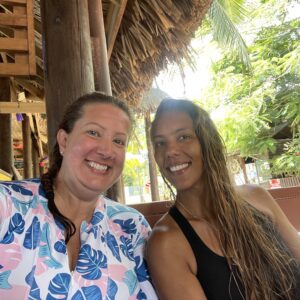
Mekela (left) with PADI Open Water Scuba Instructor Ana Meza
On the dive when Ana signaled to me to take it off, I shook my head no. She gave me the “come on just do it” look. I finally did it and immediately wanted to surface to clear my sinuses. She wouldn’t let me. She reminded me to breath slowly in and out. This helped calm my heartbeat and ease my desire to flee.
On that dive, we saw a large Spotted Eagle Ray. IT WAS SO COOL!!!! Ana said it was the oceans way of welcoming me. To complete the OW course, you learn skills in the confined water and then do four dives. You show you can do these skills while out in the open water (hence the name of the course). I was so ridiculously excited when I finished! I also had this immense sense of accomplishment. Holy cow! I am Open Water Certified!!! Something I hoped would happen but never thought it actually would.
I greatly enjoyed doing the fun dives. Occasionally, divers in the group would go to a depth that I couldn’t go to. I would literally be told to stay where I was while they explored deeper in the ocean. What the heck? Why couldn’t I go down the additional 15 or so feet?
Remember Ricky? Well, from day one, he has asked me every time he saw me, “Hey, you wanna do a night dive?” My response was always some variation of “HELL TO THE NO!”
Taking it to the next level
On Sunday, July 25, I stopped in the dive shop that morning. I asked Shannon about the night dive and if there was still room. He looked at me funny and then asked if this was for me. I said yes. I am confident that he was stunned with that answer. He gave me the rundown on it and gave me some homework to prepare for a Night Adventure Dive. He told me to be back at 4:30 for my knowledge review and to get ready for the dive.
I showed up and pretty much shocked everyone that I was there. Nick was the instructor for the night dive. Yes, Ricky was the one bugging me about it, and he missed out on it. I enjoyed seeing the really cool things that come out at night. Octopus, squid, urchins, lion fish, and more. We even saw a turtle swimming around which is not common. The highlight for me was the bioluminescent and the string of pearls. I have been wanting to see that since I heard about it in 2013.
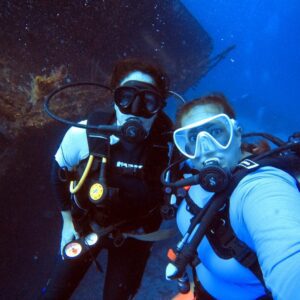
Mekela (right) and her new friend and dive buddy Elizabeth exploring the El Aguila wreck – and advanced dive in Roatan.
The next day, I was at the shop to do a fun dive. Shannon mentions to me that since I started my Night Adventure dive counts toward my PADI Advanced Open Water certification that I should just keep going with it. I met Scott on the night dive, and he wanted to continue with getting his AOW. Shannon mentioned it would be good to do together. Since I only needed to do four more Adventure Dives, I agreed. Scott and I talked about what dives to do beside Navigation and Deep which are required. Our additional three were Night, Wreck, and Peak Performance Buoyancy. By the end of the week, we were done with them all and were AOW certified!!! WOO-HOO!!!! Also, now when everyone else goes down below 60 feet to look at something, I can too.
And then the next level…
Now that AOW is complete, I would get to enjoy my last few days of fun dives before flying back to the States. During that time, Natalie mentioned in passing how she thinks I would be a good Rescue Diver. I had to ask why she thought that. She tells me that I have no issues taking charge in a situation. No, that does not mean I am bossy. It means I have great leadership skills. Also, I am absolutely not shy, so that helps too. She also mentioned she noticed how caring and concerned I was for a fellow diver I had just met on a dive we did in mid-July. Since I was going to be in the States for 7 weeks, Natalie lets me know that I am able to do one of the requisites there. At the end of those 7 weeks, I take my Emergency First Response (EFR) class. This is comprised of CPR and first-aid and some specifics for diving.
Back on the island finally!! Man, I missed this place. I did my first dive back exactly two months after my last dive. I am grateful that it was just me and Natalie. I knew I would need to reacclimate to diving, and I didn’t want to hold up a group with my freak outs. Thankfully, it was just one minor freak out in the beginning. After that, it was just like riding a bike.
During my first week back, Natalie mentions that someone else is planning to do the PADI Rescue Diver course the following week and suggested I join. It is easier with 2 people apparently. I reluctantly agree. I knew I needed to get this over with and would probably drag my feet without the push. I picked up my book over the weekend. HOLY READING!!! There is a lot to read and learn. While I was preparing for my course, I kept having a lot of uncertainty creep in. Why? Yes, this course is hard as well as rewarding. However, I had friends who recently did this course tell me things like, “It was the most difficult three days of my life.” “Man, you might regret signing up because its crazy hard.” While I appreciate the honesty, people need to keep their opinions to themselves. One comment like that could easily persuade someone to not do something. Thankfully, I was able to push that doubt aside and finished the reading and knowledge reviews before the Wednesday start.
Sweet Success!
October 13 was the first day. I also finally met my fellow Rescue Diver trainee. It was absolutely better with 2 students. This allowed our instructor Nick to observe and critique what we were doing to assure we were doing it correctly. This course was very hard. When I said there was a lot to learn, it was so much. I am grateful that we get hands-on training too. While it is a simulation, it helped me learn and retain more. After day one of training, I was exhausted! I felt like I had run a half marathon. I could not wait to get home and go to bed. Day two was just as tiring. But, after two very hard days, we were done. That Rescue Diver certification is all mine!!
How I went from zero to Rescue Diver hero
So, how did I ultimately overcome what was an almost crippling fear? By having the support and encouragement of an awesome team. Natalie could have easily laughed at my ridiculousness in the beginning, but she didn’t. I feel like other people would have very quickly lost their patience with me. That never happened in any of my courses. The staff at Sun Divers know just how far to push and when. If you aren’t ready for it yet, that is okay. They are here to support you however far you want to go on your diving journey.
Interested in learning to dive, but not sure if you’re ready to take the plunge? We’re here to help. Contact us to schedule a time to chat with a Sun Divers team member to learn more about how we can help you follow in Mekela’s courageous fin kicks and experience scuba diving safely and confidently.
The spell of the silversides
Roatan offers such an amazing variety of dive sites that are accessible all year. Each site has its own unique features from towering walls, steady drifts, and deep caverns… often, all three and more.
But, during brief windows of time, some of the sites are punctuated with a once-a-year bonus. During the month of August, we experience one of the coolest phenomena: the spawning of Silversides.
What’s so cool about Silversides?
Silversides by themselves are an inconspicuous fish about two inches long with a white-silvery sheen. However, during their annual spawning, the silversides will form massive schools in sheltered areas of the reefs. They will take up residence in some of the many swim throughs and caverns prolific around Roatan.
This experience can be mind-blowing to divers. Imagine entering a swim through…The rays of sun light fight through the many cracks and holes creating lustrous streaks that reflect off the bottom. As you get further into the cavern you begin to see the streaks of sun broken up by flashes of light in every direction. Soon, you are surrounded by a mesmerizing light show as the schooling silversides surround you. They simultaneously block the light from above and reflect it in constantly evolving patterns. As you swim through the school, the fish will open up a small tunnel while still flashing their disorienting shapes.
The ever-evolving synchronized movements combined with the flashes of light have engulfed you in their spell. Before you know it, you have spent twenty minutes in one place – losing all sense of up, down, forwards, and backwards – but you are loving every second of it.
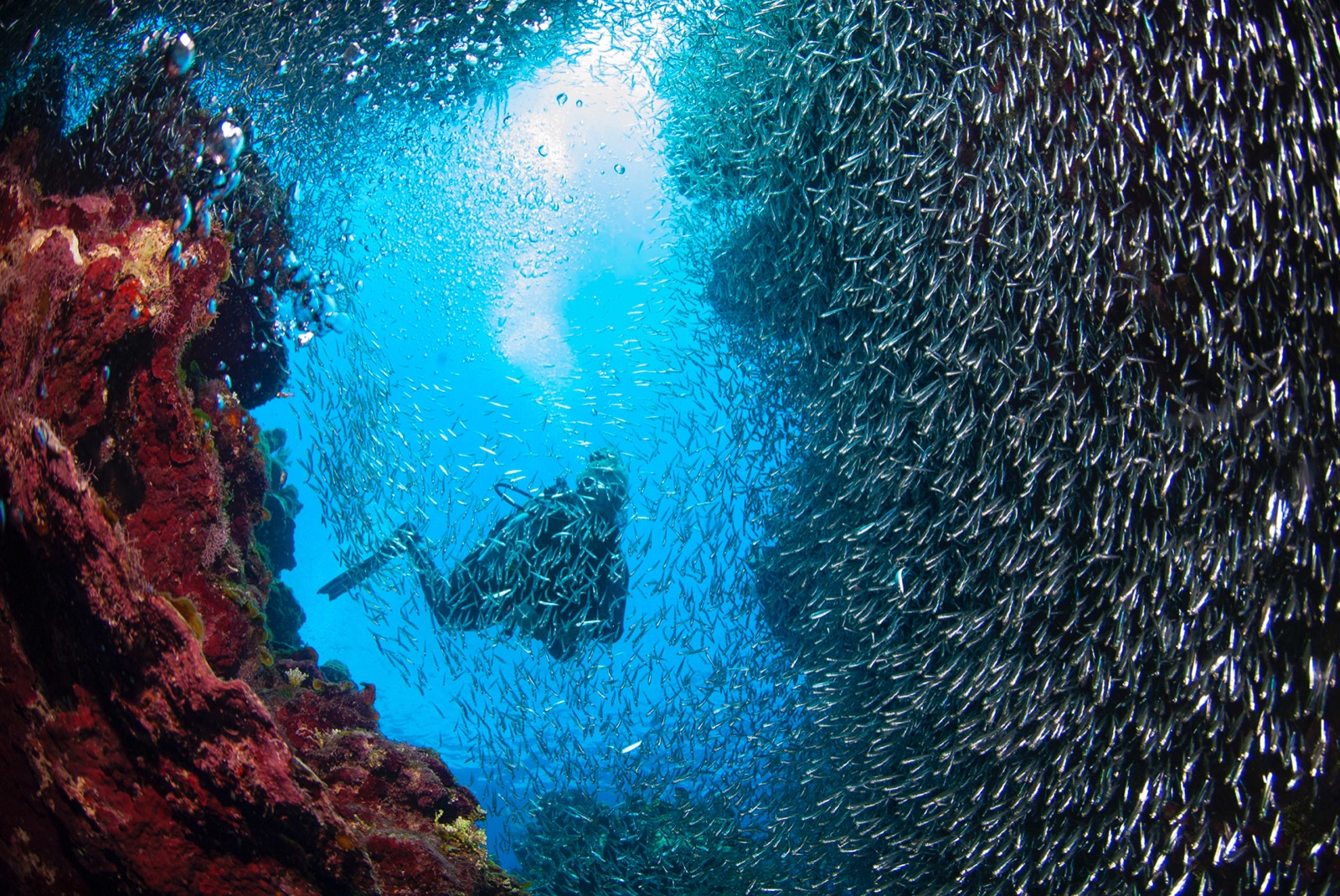
©️ Antonio Busiello
Why do Silversides just appear?
Scientifically speaking, the silversides are here for a reason. Millions of the Atlantic silversides will swell together for their annual spawning May-July. About five to 20 days later, newborns are hatched in what is called “broadcast spawning”. They travel in massive swells of schools as a form of protection and fill many nooks and crannies of the Mesoamerican reef for refuge. The silversides will feed on fish larvae, eggs, and zooplankton. Each fish is about two inches long, but the schools can feel like they go on forever. Their lifespan, unfortunately is much shorter. They can live up to two years, but many live for one as they also serve as a primary prey from larger fish and squid on the reef.
Where can I find schools of Silversides?
Some of the most popular spots for silversides include Blue Channel, Dolphin Den, Mary’s Place, Spooky Channel and more. But the schools can materialize overnight in any of the many caverns around the island.
Want the Silversides to put a spell on you?
Sun Divers will make sure to include these sites in your itinerary during your stay in August.
Contact us to plan your trip today.
Shark! Your sighting can help science
Sharks: a bucket list sighting for almost any diver, striking fascination and sometimes a small dose of fear in the hearts of us all. We’ve spotted three scalloped hammerheads on dives in just two months, making us more than a bit obsessed here at Sun Divers. And we’re not the only ones.
A new passion project in Roatan supported by the Roatan Marine Park and headed by Simon Gulak, shark biologist and founder of Sea Leucas, aims to shed some light on the little known life of sharks here in Roatan and the greater Bay Islands.
Share your shark sighting
The moment is magical. You hear the tank bang and direct your gaze to the blue. At first it’s a shadow and then there’s that undeniable dorsal fin. If you’re an underwater photographer you’re scrambling to not be all thumbs. If you’re not, you’re likely fixated. Witnessing firsthand the power and finesse of the ocean’s apex predator in the wild is something you never forget.
It’s an experience you want to share with everyone. You’ll no doubt talk about it. Post about it. Hopefully add it to our “Best Sightings of the Month” board. And now you can also share your sighting to help build the first shark count database in the Bay Islands.
Sightings help science
Honduras designated all 240,000 square kilometers of its waters as the first shark sanctuary in the Americas in 2011. Yet, we know very little about shark life, behavior and abundance (or lack thereof) in Roatan and the Bay Islands.
Limited data means limited ability to protect these beautiful creatures who are not only crucial to the health of marine ecosystems, but have been proven to be of more value to our economies when they’re alive and thriving than served on a menu.
One of the most important data points that can help protect sharks is simply establishing a baseline of their abundance. This baseline is something that does not exist in Roatan and the Bay Islands….yet. RMP and Sea Leucas have established the first ever database for shark sightings with the hopes that the entire community will contribute.
Adding your sighting is simple. Just visit the RMP Shark Sightings page to submit information about your sighting including when, where and what species was seen.
Sightings to date have included scalloped and great hammerheads, oceanic white tips and silky sharks.
What will we spot next?
The best way to find out is to dive in!
To E-Learn or Not to E-Learn?
That is the question that a lot of people have when first considering achieving a PADI certification. But, like most things in life, there isn’t a one size fits all approach to SCUBA diving certifications. And that’s actually a good thing, because it allows you to personalize your diving education journey.
So how do you know if E-Learning is right for you?
Consider three things when deciding if you should opt for the PADI E-Learning vs. a full course at your dive center of choice. 1) your personal learning style, 2) your vacation length and 3) your budget.
But, before we dig into whether E-Learning is right for you, it’s probably best that you understand exactly what your options are! We’ll use the PADI Open Water course to highlight the differences.
The PADI Open Water Diver course includes three parts:
Knowledge Development, Confined Water Dives, and Open Water Dives. Knowledge Development covers the principles, concepts and terms you need to know for dive safety and enjoyment. During the Confined Water Dives, you learn and practice scuba skills in the shallow waters of our bay (other dive centers might use a pool). Then, to complete training, you will apply and demonstrate what you’ve learned through four Open Water Dives upon the beautiful Roatan reef.
Confined water skills might not be required for the certification program such as Advanced Open Water or Specialty Certifications.
There are two ways to approach the Knowledge Development portion of all PADI certification programs:
One is through PADI E-Learning which is an online training platform that includes a mix of written education and videos. The knowledge reviews, quizzes and final exam that you’d normally take on site at the dive center are administered for your completion online prior to show up to the dive center for your course. When you start the in-person part of the course with your dive center, they will administer a set of questions for you to answer known as a “Quick Review.” This allows the instructor to see where there might be knowledge gaps that they will then help fill through discussion with you.
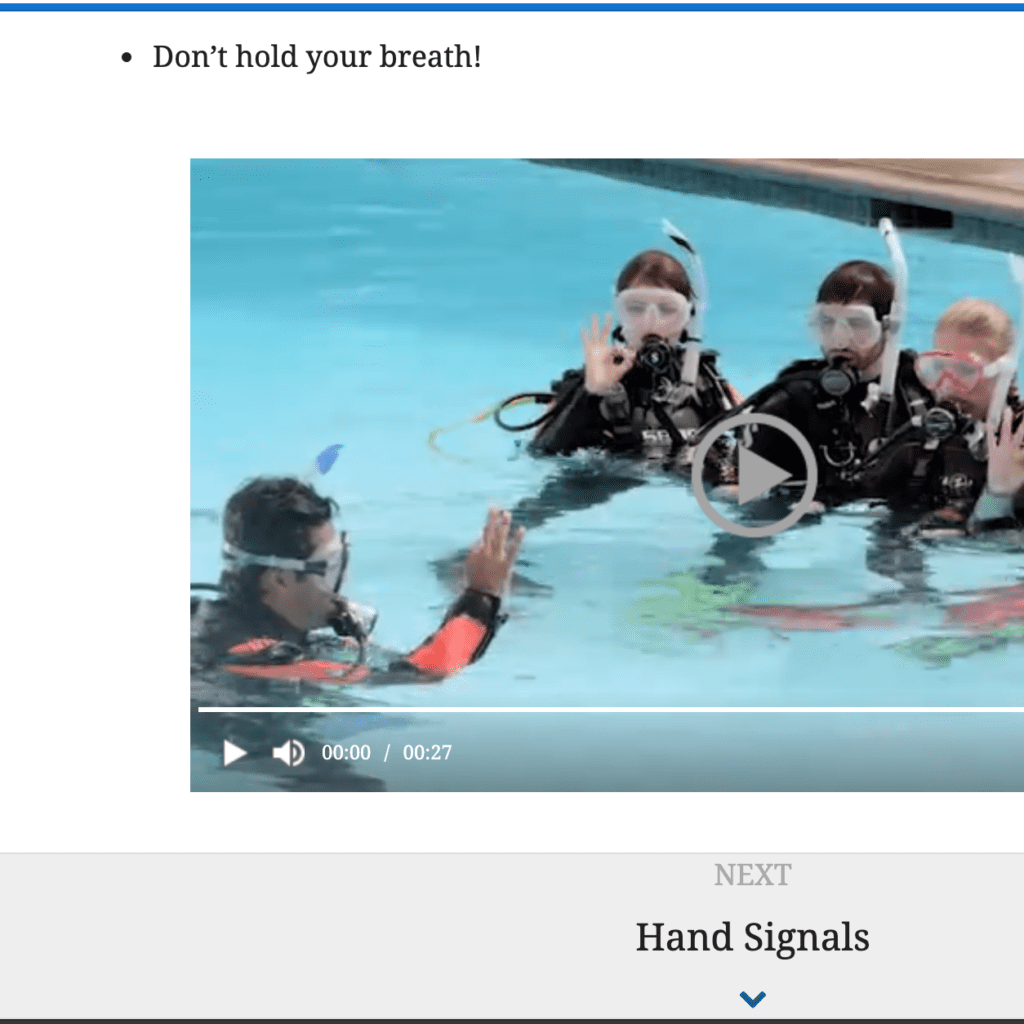
Screenshot of the multimedia PADI E-Learning platform
The second option is to take the “Full Course” at your dive center. With this option, you read a hard copy manual and answer the knowledge reviews in advance, and also must watch a series of videos. You then review the content of each of the five knowledge development sections with your instructor. With this option you’ll be able to ask more questions and hear anecdotes from your instructors experience that provide additional context to the theory. Quizzes are taken on site and reviewed with your instructor, as is the final exam.
With both options, you still must complete the confined and open water skills in person – there are just some things that can’t be done in a virtual world (yet!).
Is E-Learning right for your learning style?
Spoiler alert: Learning “styles” are a myth! Many of us have probably been told that we are either predominantly a visual, auditory and kinesthetic learners. And that when trying to process and learn new information, it should be taught to us in the style that’s our dominant learning style.
Cognitive research today has thoroughly debunked this myth. Plus, the PADI e-learning platform is an engaging mix of reading, informational images / graphics and videos hitting on both visual and auditory learning. Combine that with the kinesthetic confined and open water skills and you’ve used all senses to learn.
So if you think e-learning is not for you, you might just think again. Unless you just really prefer the experience of a “real” book vs. more screen time.
Will E-Learning give you more time to enjoy your vacation?
Absolutely. A typical full course will take 3 – 3.5 days to complete based upon your own rate of progress. E-Learning typically takes 2.5 – 3 days. That means more time for you to maximize your vacation – either moving on to fun diving after certification or freeing you up to incorporate other activities into your vacation.
Does E-Learning Cost More?
In short, yes. But as the saying goes, “time is money” and it’s just a matter of how much your time – especially your vacation time – is worth to you. Compare E-Learning prices here to decide whether it’s worth it to you.
Now that you know some of the differences between E-Learning and PADI’s traditional methods of instruction, it’s time to decide which is right for you. Still have questions? Don’t hesitate to reach out and ask!
The case for coral nurseries in Roatan
As you make your way for your safety stop at Seaquest, all of a sudden it comes into focus: An underwater forest of manmade tree-like contraptions. Little bits of coral dangle from these metal ‘trees’ like Christmas ornaments. What you’ve happened upon is the Roatan Marine Park’s Coral Restoration Nursery. The nursery is a super cool location to spot slender file fish, squid squads and even turtles and eagle rays – but it’s purpose is even cooler than that. The nursery is designed to ‘grow’ coral fragments that can then be outplanted onto the reef in order to increase coral coverage with more resilient coral species.
Wait – how do you grow coral?!
First it starts with the coral fragments. Broken bits of Elkhorn, Staghorn and Prolifera coral (which is a hybrid of the two) are recovered from the reef and then hung from the trees. Here they can avoid predators such as fireworms and snails while benefiting from increased sunlight and well-circulated water free flowing amongst the trees.
Much like a plant nursery, these smaller fragments are essentially nursed back to health (pun intended!), so that they can grow into larger, stronger fragments that will survive being outplanted back onto the reef. The more mature corals are then taken to the Roatan dive site Chiefs Quarters where they are “planted” using two-part epoxy. Many times they are positioned near existing coral colonies of the same species which indicate that the location is an area where the coral transplants will thrive.
Why do corals matter anyway?
Reefs cover only .2% of the ocean floor yet sustain 25% of marine life. They also contribute greatly to our lives providing recreation, billions of jobs and coastline protection. Not to mention, the joy, peace and exhilaration we experience when we get to connect underwater to the beauty of the reefs.
That’s a pretty big job for such a small population of coral. Yet, this all-too-important and already limited ecosystem is under attack from warming sea temps, diseases such as Stony Coral Tissue Loss Disease damage from ships of all kinds, and destruction from construction such as port dredging.
As coral coverage diminishes, so will the home to thousands of species of fish, invertebrates, marine mammals and more. So will our ability to spark joy from exploring the reef while scuba diving. And so will the protection from storms and erosion, as well as the foundation for billions of jobs worldwide.
In short, a world without corals is not one we’re excited about living in or raising our children to have to struggle with.
What’s the coral situation in Roatan?
The MesoAmerican Barrier Reef in Roatan is under the same catastrophic stressors as reefs around the world. To help offset the loss of coral colonies seen here on the island, The Roatan Marine Park has developed a nursery with 20 trees. Since the nursery’s installation in 2019, over 300 coral fragments have been outplanted. The next steps: continuing to expand the program, while also monitoring the outplanted coral for future growth and spawning (to ensure corals are self-propagating).
So now you’re saying ‘Cool, I want to help plant coral!’
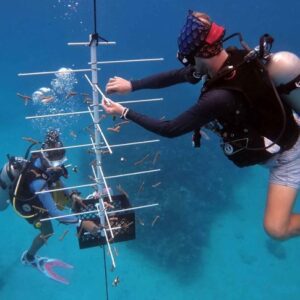
Sun Diver team members Nick Griffiths and Ana Meza attach coral fragments to a tree.
You’re in luck. Divers have an opportunity to become volunteers through the Coral Restoration Ambassador program. As a Coral Restoration Program Certified Dive Center, we can certify you so that you
can perform basic tree maintenance, help repair trees that have been damaged from storms and surge, and even assist with outplanting and data monitoring. There are two certification levels and the course can be completed in just a couple days. Learn more about how to become a certified RMP Coral Ambassador.
If you’re not on the island and won’t be anytime soon: what are you waiting for? Book your ticket!! But you can also support form afar by donating to RMP’s program. Donations help fund nursery operations, permits to keep the program running, and ongoing analysis to improve future program decision.



